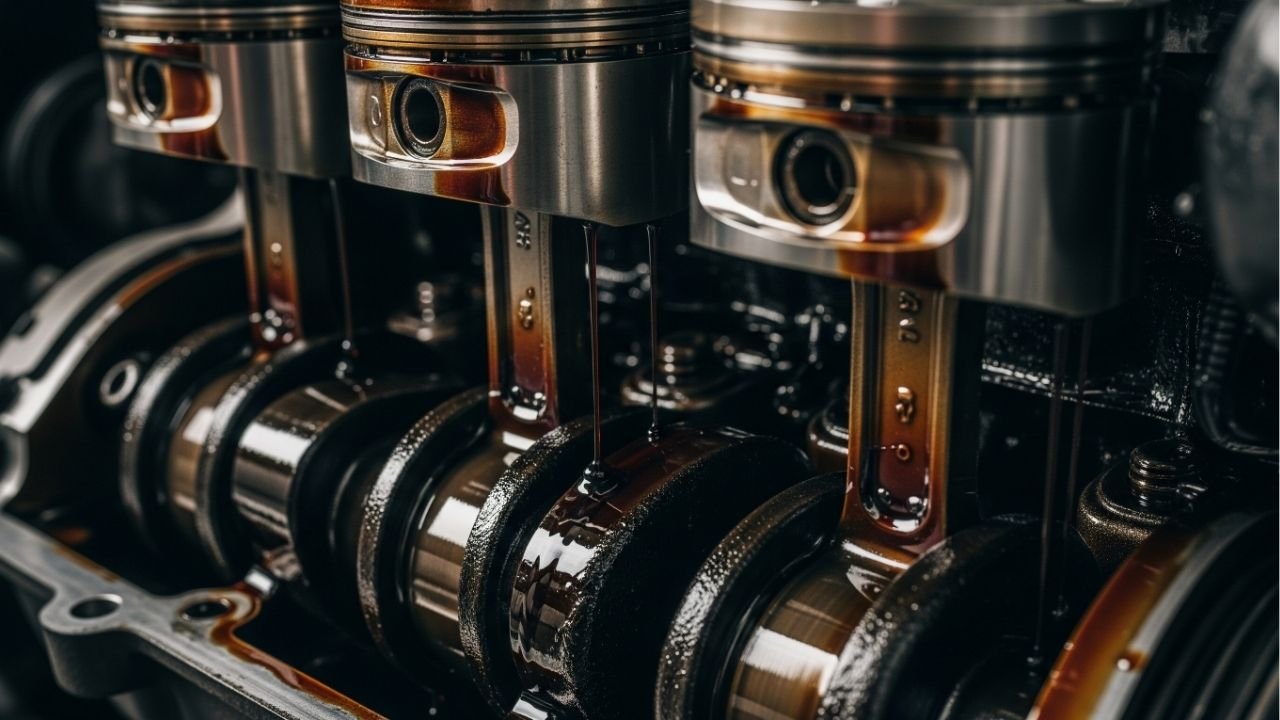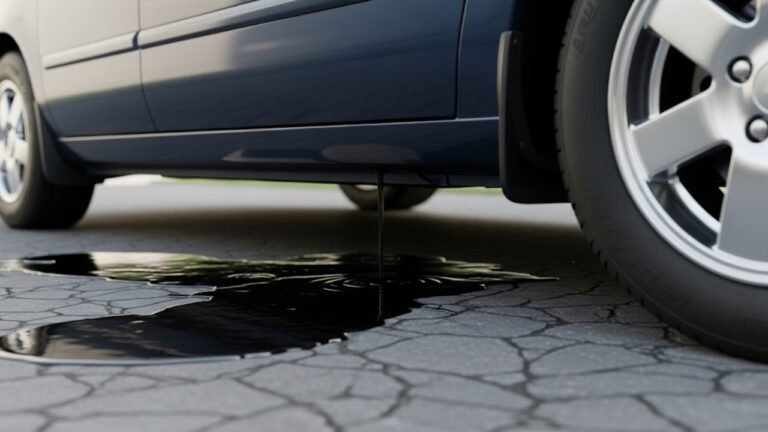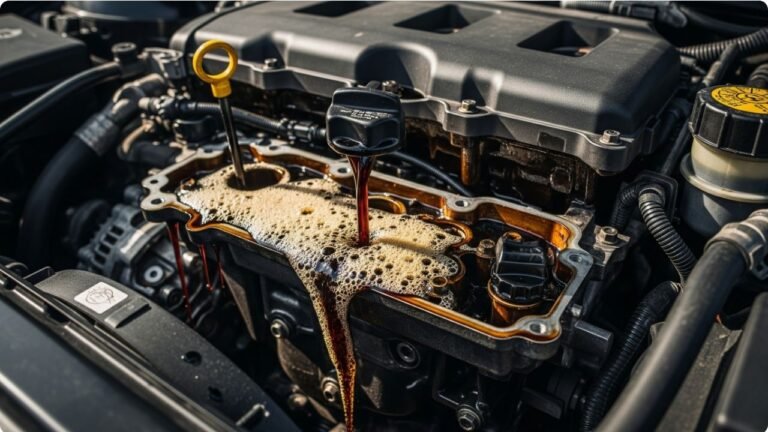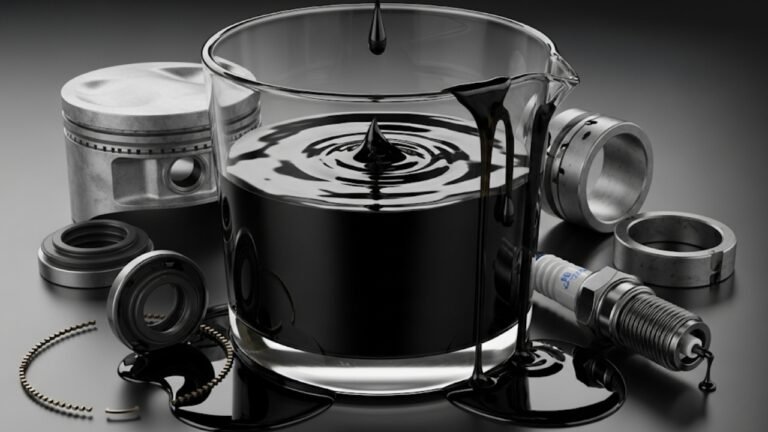What Happens If There Is Too Much Oil in a Car?

Let me ask you something. Have you ever filled your engine oil and then thought, “Hmm, maybe just a little more for good luck?” We’ve all been there, right? You’re trying to do the right thing. You care about your car. But what if I told you that too much oil in a car can do more harm than good?
Engine oil keeps everything running smoothly—kind of like blood in our body. It lubricates the moving parts, cools them down, and helps carry away the nasty stuff. But just like with anything in life—too much of a good thing can backfire. Overfilling your oil might seem harmless, but trust me, it can lead to serious trouble.
Let’s break down what really happens when you pour in that extra bit of oil and how you can avoid turning your car into a ticking time bomb.
Why Too Much Oil is a Bigger Deal Than You Think

When the oil level rises above the recommended mark, the crankshaft dips into the oil. This causes the oil to whip into foam—just like whisking cream. But engines don’t like foamy oil. It can’t lubricate properly. It loses its smooth flow. That’s where problems begin.
Key dangers include:
-
Oil leaks due to high pressure
-
Damaged seals and gaskets
-
Increased engine wear
-
Poor performance and mileage
-
Risk of complete engine failure
Let that sink in. Overfilling isn’t just messy. It’s mechanical sabotage—by accident.
What Happens Inside the Engine: A Simple Breakdown
Imagine your engine is like a heart pumping fluid through veins. It needs precision. Oil levels are calibrated for perfect flow. Now, when you overfill, that balance breaks.
Here’s what actually happens step by step:
-
Excess oil reaches the crankshaft.
-
The crankshaft churns the oil into foam.
-
Foamy oil loses lubrication qualities.
-
Engine parts grind instead of glide.
-
Heat builds up. Friction increases.
-
Pressure inside the engine rises.
-
Gaskets and seals give in. Leaks begin.
-
In worst cases, hydro-lock occurs—where oil enters the combustion chamber.
It’s not instant death, but it’s silent damage over time. And if ignored, it becomes a loud, expensive problem.
Real-Life Signs You’ve Overfilled Your Oil
How do you know if there’s too much oil in a car? Luckily, your car talks—not in words, but in signs. You just need to listen.
Watch out for these warning signals:
-
White or blue exhaust smoke (burning oil)
-
Strong burning smell inside the cabin
-
Oil leaks under the engine
-
Rough idling or poor acceleration
-
Check Engine Light or Oil Light on the dashboard
Here’s a relatable story: My cousin once thought he was being extra responsible. He filled up “just a bit more” oil. Two days later, his car started smoking on the highway. Turned out, the oil was overflowing and burning. Lesson learned.
Pro Tip: Always check your oil level with the dipstick after an oil change. Don’t guess.
How to Check If You Overfilled Your Oil
The good news? You don’t need to be a mechanic to catch an overfill. A simple dipstick test can save you thousands of takas (or dollars).
Here’s how to check your oil the right way:
-
Park on a level surface.
-
Wait 10-15 minutes after turning off the engine.
-
Pull out the dipstick and wipe it clean.
-
Insert it fully and pull it out again.
-
Look at the oil level—if it’s above the MAX mark, you’ve overfilled.
Table: Dipstick Oil Level Interpretation
| Oil Level Reading | What It Means | Action Required |
|---|---|---|
| Below MIN | Too little oil | Add oil |
| Between MIN and MAX | Perfect range | No action needed |
| Slightly above MAX | Slight overfill | Monitor or remove a little |
| Well above MAX | Dangerous overfill | Drain excess oil immediately |
Don’t ignore that high mark. Removing a bit of oil now can save your engine later.
The Technical Side: What Parts Get Affected?
Okay, let’s geek out just a little. When there’s too much oil in a car, several parts of your engine are at risk. Each of them plays a key role.
-
Crankshaft – Gets submerged and starts whipping oil into froth.
-
Oil Seals – They aren’t designed for extra pressure. They break down.
-
Piston Rings – Oil can slip past them, leading to combustion issues.
-
Catalytic Converter – Excess oil burns and clogs this, costing you performance (and money).
-
Air Intake – Sometimes oil even gets into here, causing misfires or stalling.
In short, it’s not just about oil being too high—it’s about how it touches everything it shouldn’t.
Cost of Ignoring the Problem
Let’s talk money—because let’s face it, this stuff adds up fast. Here’s a quick snapshot of potential costs:
Estimated Repair Costs in USD (or equivalent in BDT)
| Repair Type | Cost Estimate (USD) | Cost Estimate (BDT) |
|---|---|---|
| Oil Seal Replacement | $150 – $400 | ৳15,000 – ৳45,000 |
| Catalytic Converter Repair | $900 – $2,500 | ৳90,000 – ৳2,50,000 |
| Engine Rebuild (Worst Case) | $2,500 – $5,000+ | ৳2,50,000 – ৳5,00,000+ |
For something as simple as checking your dipstick, why take the risk?
How to Fix Overfilled Oil – Step-by-Step
Messed up and poured in too much oil? No stress. You can fix it. Here’s how:
Method 1: Use an Oil Extractor Pump
-
Insert the tube into the dipstick tube.
-
Pump out small amounts at a time.
-
Check the level after every pull.
Method 2: Drain from the Plug
-
Put on gloves and get under the car.
-
Place a pan under the oil drain plug.
-
Open slowly—drain just a bit.
-
Re-check with the dipstick.
Method 3: Go to a Mechanic
-
If you’re unsure, don’t risk it.
-
It’s cheaper to pay a little now than a lot later.
Tip: Always recheck oil after any fix. Let the engine run for 5 minutes and check again.
Common Myths About Oil Overfill (Busted!)
There’s a lot of confusion out there. Let’s clear the air:
-
Myth: “A bit more oil won’t hurt.”
Fact: Even a small overfill can foam and reduce lubrication. -
Myth: “Cars burn oil anyway.”
Fact: That doesn’t mean you should pre-compensate. -
Myth: “New cars can handle more oil.”
Fact: They’re built with tighter tolerances. Overfilling is even riskier!
Prevention is Better Than Cure: How to Avoid Overfilling Oil
Let’s be real—most of us aren’t mechanics. We’re just trying to do right by our cars. But the best way to avoid damage is by preventing it in the first place. Here are some simple yet powerful habits to keep in mind:
-
Read your car’s manual. It tells you the exact oil capacity your engine needs.
-
Use the right funnel. This prevents accidental spills and overpours.
-
Measure before you pour. If your engine takes 4 liters, don’t guess—use a measuring jug.
-
Wait before topping off. Let the oil settle, then check again.
-
Get regular oil changes. Old oil can be thicker and harder to read on the dipstick.
These habits sound basic, but they’re lifesavers. Think of them as brushing your teeth—small steps, big impact.
A Cultural Look: Car Care Across Borders
Let’s add some flavor. Back in Bangladesh, especially in rural towns, it’s common to trust the local garage guy for car maintenance. You roll in, grab a cup of tea, and watch him do his thing. But sometimes, he’ll pour oil generously, thinking he’s helping.
In the U.S., people often DIY with oil change kits at home. And in Japan? Car owners are so precise they’ll use digital dipsticks.
Different cultures, different habits—but the problem of too much oil in a car? It’s universal.
No matter where you are, understanding your vehicle gives you control. Cars may differ, but engines speak the same language worldwide.
Empathy Moment: I’ve Been There Too
Let me be honest—I’ve made this mistake myself. A few years back, I overfilled my Toyota Corolla by half a liter. I didn’t think much of it until I noticed a burning smell on my way to a wedding.
I was in a rush, stuck in traffic, suit sweating through, and there’s this weird smoke from under the hood. Panic set in. Long story short—I had to pay for gasket repair and missed half the wedding.
That day, I learned something valuable: knowing your oil level is power. It’s one of those things that doesn’t matter… until it really does.
Bullet Points: Quick Summary of What to Remember
Sometimes, all we need is a cheat sheet. Here’s a quick round-up:
-
Too much oil causes foaming, leaks, and engine strain.
-
Always check the dipstick after pouring oil.
-
Stop at the MAX line—no more.
-
Watch for smoke, burning smells, or warning lights.
-
Drain excess oil immediately if overfilled.
-
Prevention is easier (and cheaper) than repair.
FAQs About Too Much Oil in a Car
1. How much oil is too much in a car?
If your oil level is more than 1/4 inch above the MAX line, that’s too much. Even a small overfill can cause damage.
2. Can too much oil damage your engine permanently?
Yes. Over time, it leads to wear, oil seal damage, and even engine failure if ignored.
3. Will overfilling oil fix low oil pressure?
Nope. That’s a myth. It might make things worse. Low oil pressure needs proper diagnosis—not a top-up guess.
4. Is it safe to drive with a little too much oil?
Short distances? Maybe. But it’s risky. Long drives or high speeds can foam the oil, damaging your engine.
5. How do I safely remove excess oil?
Use an oil extractor or drain plug. Or visit a trusted mechanic. Always re-check levels after draining.
6. Can overfilled oil cause white smoke?
Yes. Burning oil produces white or bluish smoke from your exhaust—an early red flag.
7. Is it better to have more oil than less?
Neither is good. Think of oil like medicine—the right dose keeps things healthy. Too much or too little causes harm.
8. What’s the best time to check engine oil?
Morning, when the engine is cool and oil has settled. Park level. Wait a few minutes if just driven.
Final Thoughts: The Dipstick Is Your Best Friend
When you’re in a rush, adding “just a bit more” oil feels harmless. But now you know—it’s not.
Think of engine oil like cooking salt. A pinch too little? Mild. A pinch too much? Ruins the dish. The balance is everything.
Trust your dipstick. It tells the truth. Check it often. Respect its guidance. If you ever feel unsure, ask for help. Cars are complicated, but your care for them doesn’t have to be.
Taking 3 minutes to check your oil can save you 3 lakh taka (or more) down the line. That’s smart driving.






